ECE1890 - Bridging the Gap: Childcare Centre Assessment Report
VerifiedAdded on 2022/08/21
|6
|971
|12
Report
AI Summary
This report, submitted by a student, assesses the operational effectiveness of the Waterloo Infant Daycare in Canada. The assignment analyzes the daycare's program statement, highlighting three key values: creating a holistic learning environment, developing learning using a pedagogical approach, and promoting diversity. The report provides examples of successes, such as fostering social skills and emotional growth, and failures, like potential cultural assimilation issues and the stress of standardized learning. It evaluates the rationales behind operational efficiency and failure, discussing how the daycare's practices contribute to child development, particularly for immigrant children, while also acknowledging potential drawbacks such as the risk of cultural disconnect and learning complexities. The student uses references to support their analysis, offering a comprehensive overview of the daycare's practices and their impact on children.
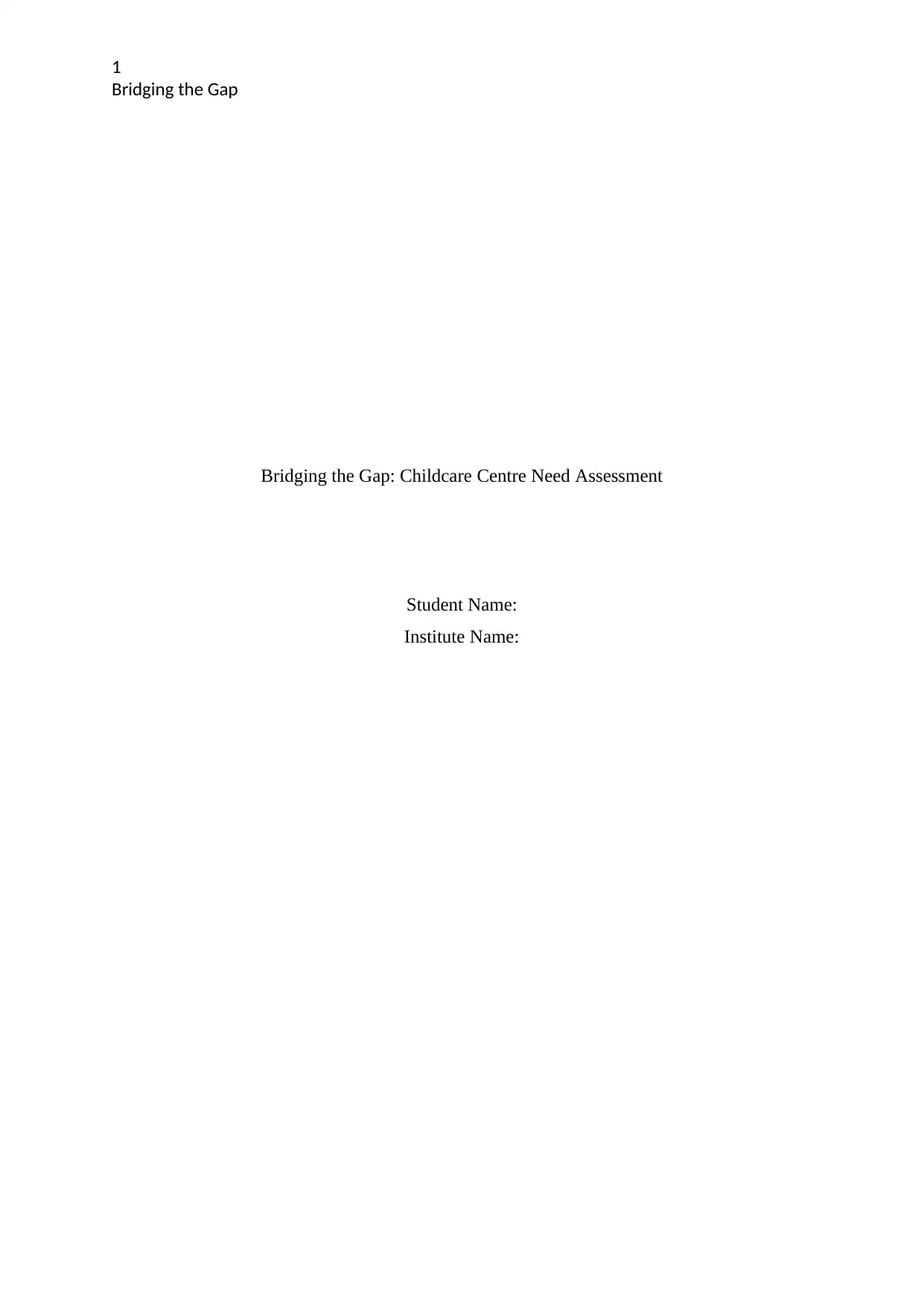
1
Bridging the Gap
Bridging the Gap: Childcare Centre Need Assessment
Student Name:
Institute Name:
Bridging the Gap
Bridging the Gap: Childcare Centre Need Assessment
Student Name:
Institute Name:
Paraphrase This Document
Need a fresh take? Get an instant paraphrase of this document with our AI Paraphraser
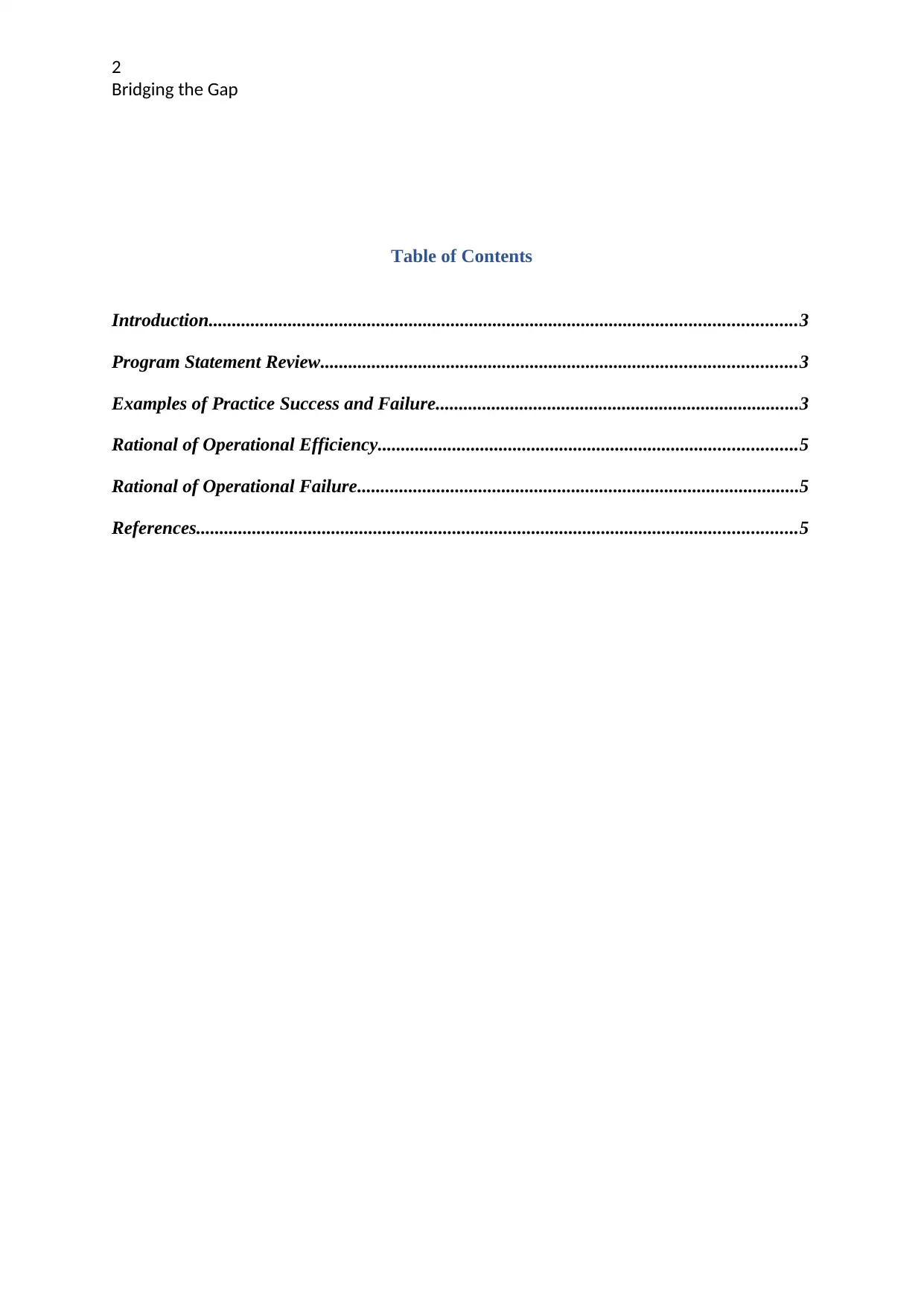
2
Bridging the Gap
Table of Contents
Introduction..............................................................................................................................3
Program Statement Review......................................................................................................3
Examples of Practice Success and Failure..............................................................................3
Rational of Operational Efficiency..........................................................................................5
Rational of Operational Failure...............................................................................................5
References.................................................................................................................................5
Bridging the Gap
Table of Contents
Introduction..............................................................................................................................3
Program Statement Review......................................................................................................3
Examples of Practice Success and Failure..............................................................................3
Rational of Operational Efficiency..........................................................................................5
Rational of Operational Failure...............................................................................................5
References.................................................................................................................................5
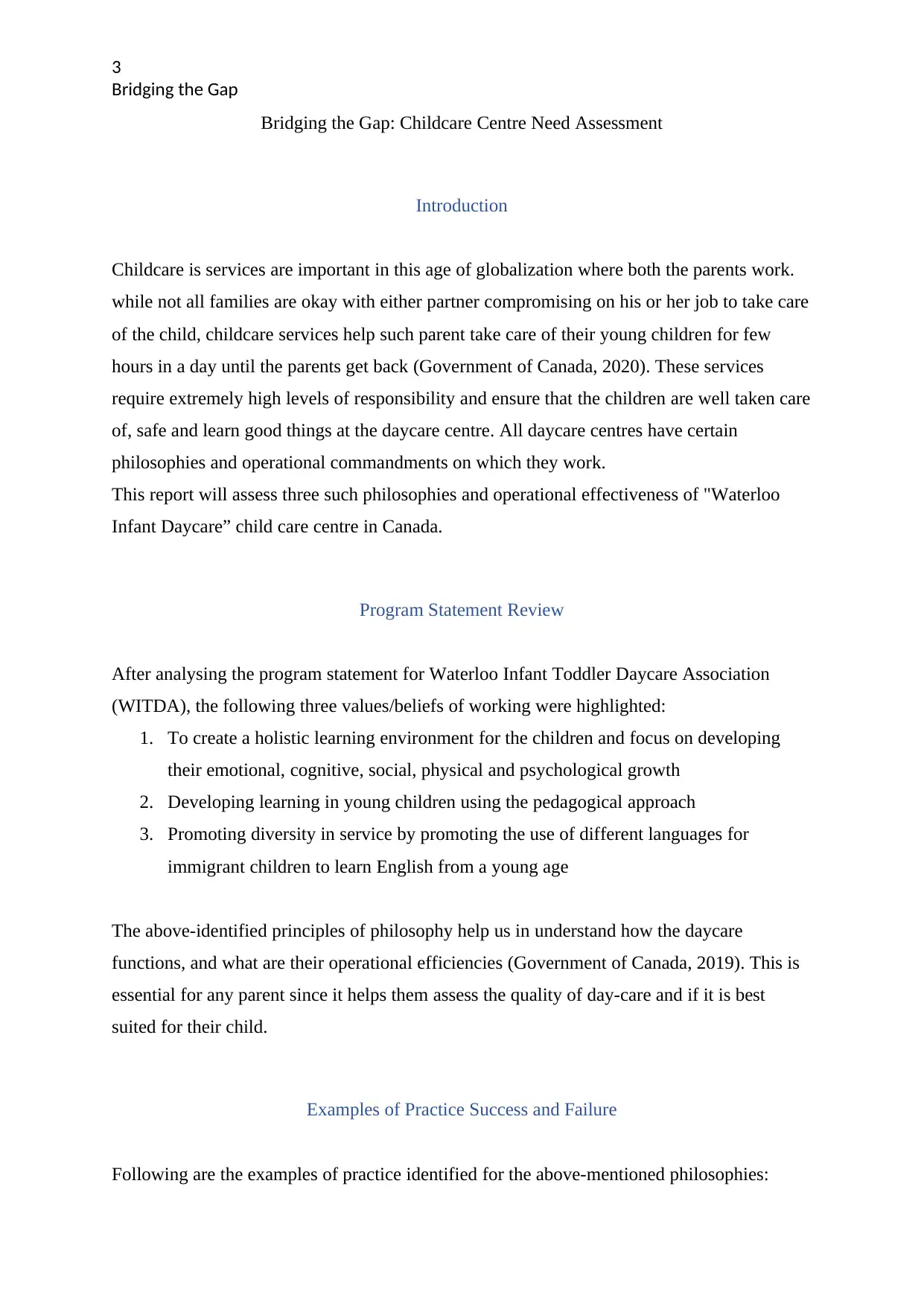
3
Bridging the Gap
Bridging the Gap: Childcare Centre Need Assessment
Introduction
Childcare is services are important in this age of globalization where both the parents work.
while not all families are okay with either partner compromising on his or her job to take care
of the child, childcare services help such parent take care of their young children for few
hours in a day until the parents get back (Government of Canada, 2020). These services
require extremely high levels of responsibility and ensure that the children are well taken care
of, safe and learn good things at the daycare centre. All daycare centres have certain
philosophies and operational commandments on which they work.
This report will assess three such philosophies and operational effectiveness of "Waterloo
Infant Daycare” child care centre in Canada.
Program Statement Review
After analysing the program statement for Waterloo Infant Toddler Daycare Association
(WITDA), the following three values/beliefs of working were highlighted:
1. To create a holistic learning environment for the children and focus on developing
their emotional, cognitive, social, physical and psychological growth
2. Developing learning in young children using the pedagogical approach
3. Promoting diversity in service by promoting the use of different languages for
immigrant children to learn English from a young age
The above-identified principles of philosophy help us in understand how the daycare
functions, and what are their operational efficiencies (Government of Canada, 2019). This is
essential for any parent since it helps them assess the quality of day-care and if it is best
suited for their child.
Examples of Practice Success and Failure
Following are the examples of practice identified for the above-mentioned philosophies:
Bridging the Gap
Bridging the Gap: Childcare Centre Need Assessment
Introduction
Childcare is services are important in this age of globalization where both the parents work.
while not all families are okay with either partner compromising on his or her job to take care
of the child, childcare services help such parent take care of their young children for few
hours in a day until the parents get back (Government of Canada, 2020). These services
require extremely high levels of responsibility and ensure that the children are well taken care
of, safe and learn good things at the daycare centre. All daycare centres have certain
philosophies and operational commandments on which they work.
This report will assess three such philosophies and operational effectiveness of "Waterloo
Infant Daycare” child care centre in Canada.
Program Statement Review
After analysing the program statement for Waterloo Infant Toddler Daycare Association
(WITDA), the following three values/beliefs of working were highlighted:
1. To create a holistic learning environment for the children and focus on developing
their emotional, cognitive, social, physical and psychological growth
2. Developing learning in young children using the pedagogical approach
3. Promoting diversity in service by promoting the use of different languages for
immigrant children to learn English from a young age
The above-identified principles of philosophy help us in understand how the daycare
functions, and what are their operational efficiencies (Government of Canada, 2019). This is
essential for any parent since it helps them assess the quality of day-care and if it is best
suited for their child.
Examples of Practice Success and Failure
Following are the examples of practice identified for the above-mentioned philosophies:
⊘ This is a preview!⊘
Do you want full access?
Subscribe today to unlock all pages.

Trusted by 1+ million students worldwide
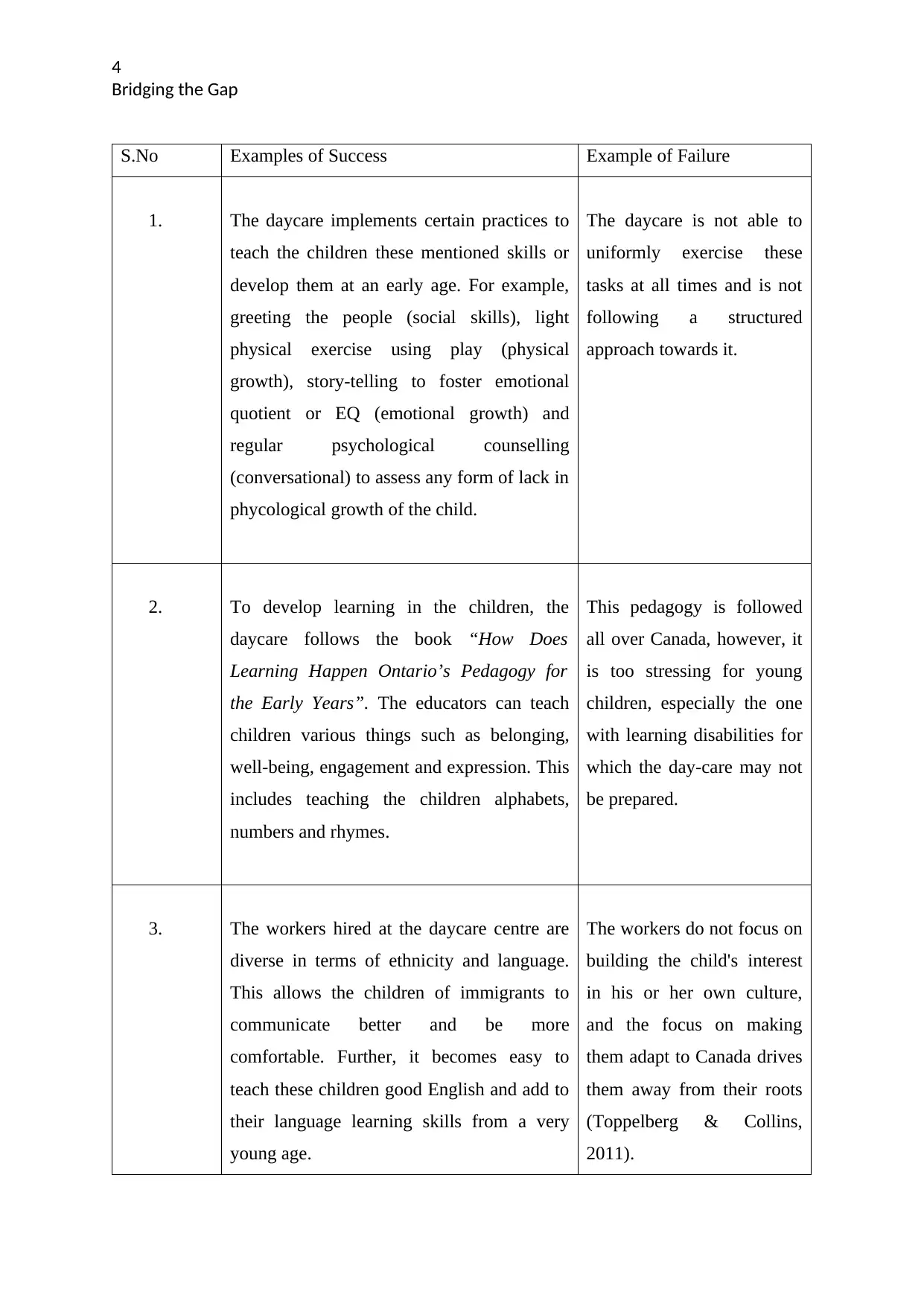
4
Bridging the Gap
S.No Examples of Success Example of Failure
1. The daycare implements certain practices to
teach the children these mentioned skills or
develop them at an early age. For example,
greeting the people (social skills), light
physical exercise using play (physical
growth), story-telling to foster emotional
quotient or EQ (emotional growth) and
regular psychological counselling
(conversational) to assess any form of lack in
phycological growth of the child.
The daycare is not able to
uniformly exercise these
tasks at all times and is not
following a structured
approach towards it.
2. To develop learning in the children, the
daycare follows the book “How Does
Learning Happen Ontario’s Pedagogy for
the Early Years”. The educators can teach
children various things such as belonging,
well-being, engagement and expression. This
includes teaching the children alphabets,
numbers and rhymes.
This pedagogy is followed
all over Canada, however, it
is too stressing for young
children, especially the one
with learning disabilities for
which the day-care may not
be prepared.
3. The workers hired at the daycare centre are
diverse in terms of ethnicity and language.
This allows the children of immigrants to
communicate better and be more
comfortable. Further, it becomes easy to
teach these children good English and add to
their language learning skills from a very
young age.
The workers do not focus on
building the child's interest
in his or her own culture,
and the focus on making
them adapt to Canada drives
them away from their roots
(Toppelberg & Collins,
2011).
Bridging the Gap
S.No Examples of Success Example of Failure
1. The daycare implements certain practices to
teach the children these mentioned skills or
develop them at an early age. For example,
greeting the people (social skills), light
physical exercise using play (physical
growth), story-telling to foster emotional
quotient or EQ (emotional growth) and
regular psychological counselling
(conversational) to assess any form of lack in
phycological growth of the child.
The daycare is not able to
uniformly exercise these
tasks at all times and is not
following a structured
approach towards it.
2. To develop learning in the children, the
daycare follows the book “How Does
Learning Happen Ontario’s Pedagogy for
the Early Years”. The educators can teach
children various things such as belonging,
well-being, engagement and expression. This
includes teaching the children alphabets,
numbers and rhymes.
This pedagogy is followed
all over Canada, however, it
is too stressing for young
children, especially the one
with learning disabilities for
which the day-care may not
be prepared.
3. The workers hired at the daycare centre are
diverse in terms of ethnicity and language.
This allows the children of immigrants to
communicate better and be more
comfortable. Further, it becomes easy to
teach these children good English and add to
their language learning skills from a very
young age.
The workers do not focus on
building the child's interest
in his or her own culture,
and the focus on making
them adapt to Canada drives
them away from their roots
(Toppelberg & Collins,
2011).
Paraphrase This Document
Need a fresh take? Get an instant paraphrase of this document with our AI Paraphraser
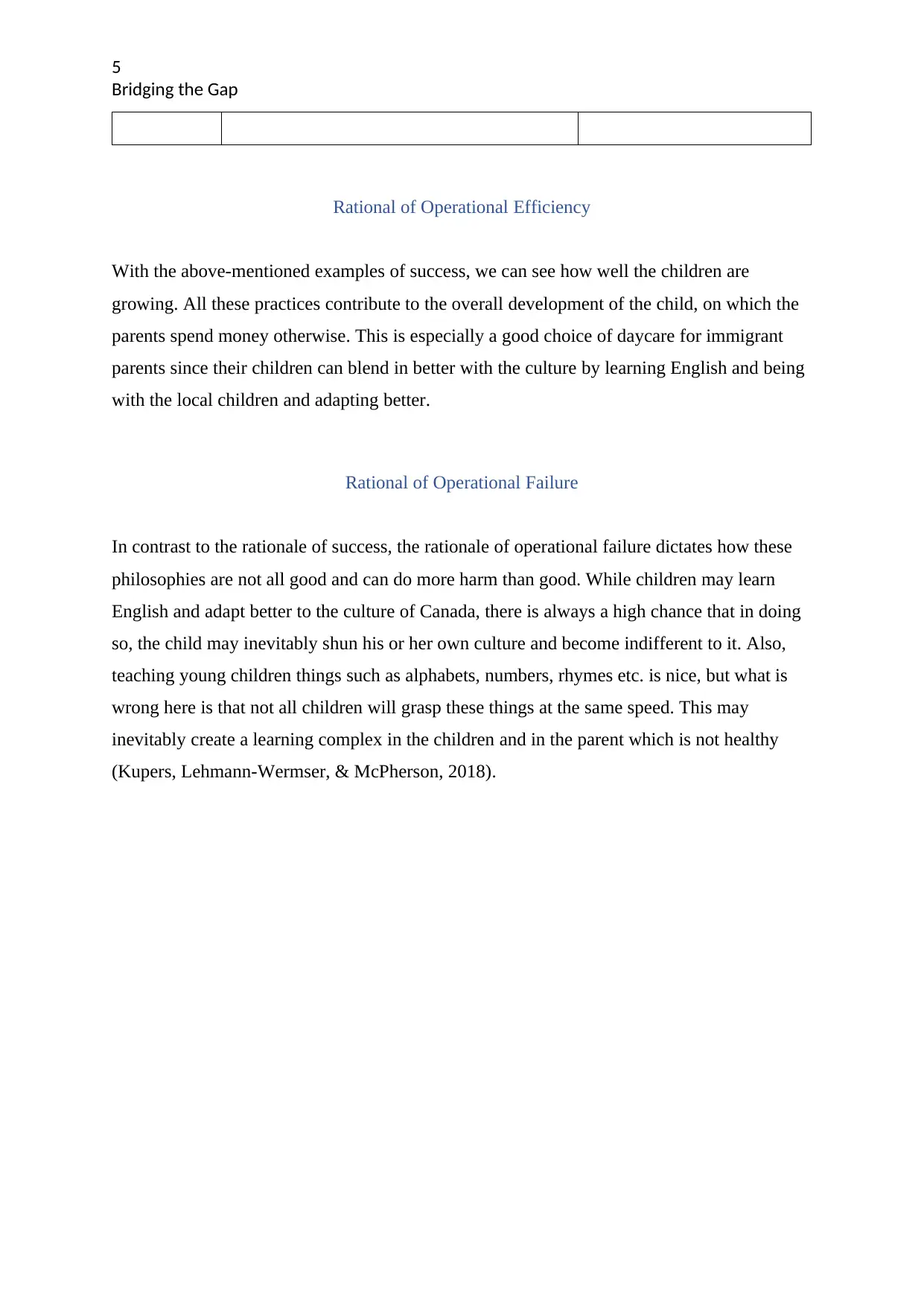
5
Bridging the Gap
Rational of Operational Efficiency
With the above-mentioned examples of success, we can see how well the children are
growing. All these practices contribute to the overall development of the child, on which the
parents spend money otherwise. This is especially a good choice of daycare for immigrant
parents since their children can blend in better with the culture by learning English and being
with the local children and adapting better.
Rational of Operational Failure
In contrast to the rationale of success, the rationale of operational failure dictates how these
philosophies are not all good and can do more harm than good. While children may learn
English and adapt better to the culture of Canada, there is always a high chance that in doing
so, the child may inevitably shun his or her own culture and become indifferent to it. Also,
teaching young children things such as alphabets, numbers, rhymes etc. is nice, but what is
wrong here is that not all children will grasp these things at the same speed. This may
inevitably create a learning complex in the children and in the parent which is not healthy
(Kupers, Lehmann-Wermser, & McPherson, 2018).
Bridging the Gap
Rational of Operational Efficiency
With the above-mentioned examples of success, we can see how well the children are
growing. All these practices contribute to the overall development of the child, on which the
parents spend money otherwise. This is especially a good choice of daycare for immigrant
parents since their children can blend in better with the culture by learning English and being
with the local children and adapting better.
Rational of Operational Failure
In contrast to the rationale of success, the rationale of operational failure dictates how these
philosophies are not all good and can do more harm than good. While children may learn
English and adapt better to the culture of Canada, there is always a high chance that in doing
so, the child may inevitably shun his or her own culture and become indifferent to it. Also,
teaching young children things such as alphabets, numbers, rhymes etc. is nice, but what is
wrong here is that not all children will grasp these things at the same speed. This may
inevitably create a learning complex in the children and in the parent which is not healthy
(Kupers, Lehmann-Wermser, & McPherson, 2018).
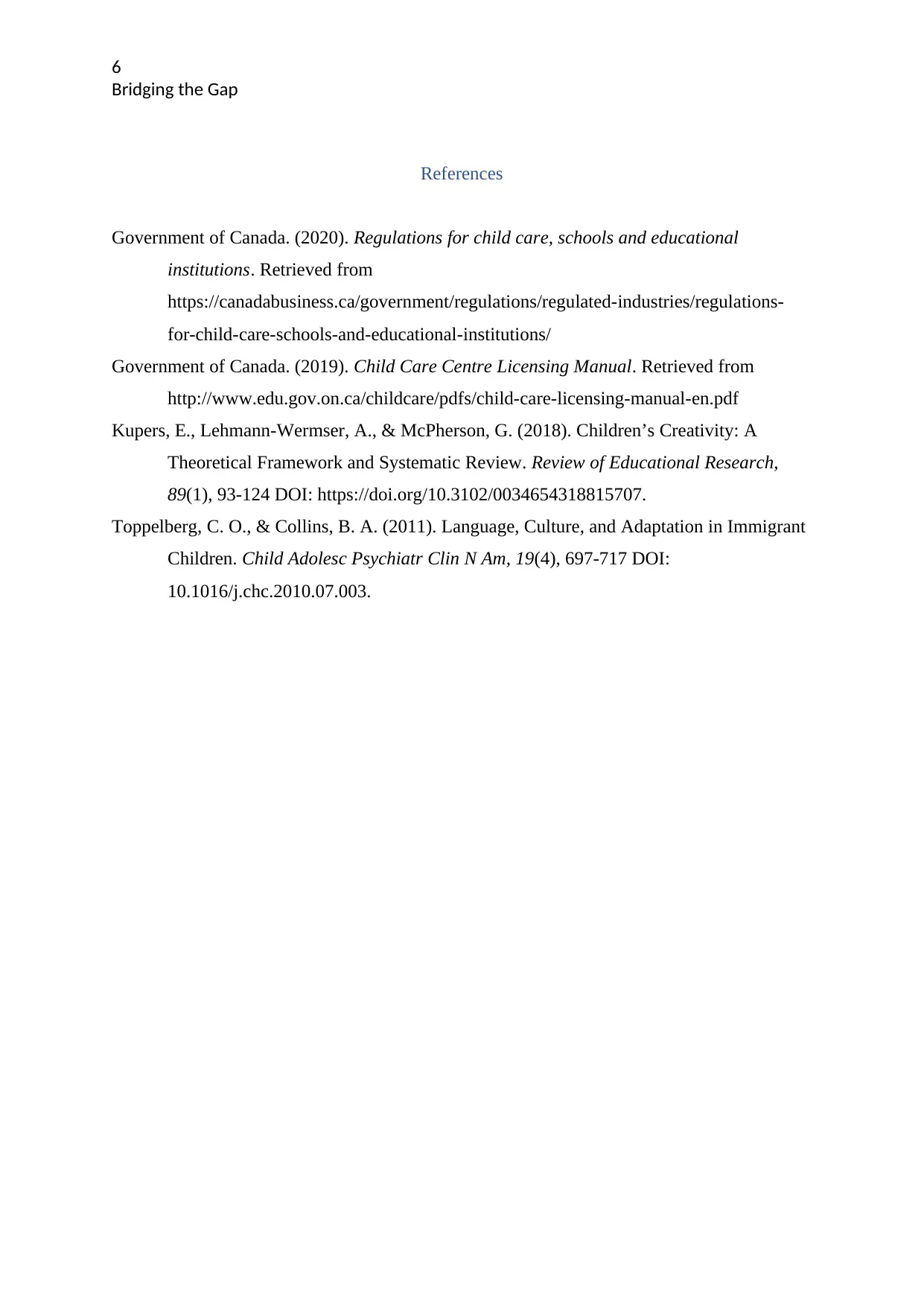
6
Bridging the Gap
References
Government of Canada. (2020). Regulations for child care, schools and educational
institutions. Retrieved from
https://canadabusiness.ca/government/regulations/regulated-industries/regulations-
for-child-care-schools-and-educational-institutions/
Government of Canada. (2019). Child Care Centre Licensing Manual. Retrieved from
http://www.edu.gov.on.ca/childcare/pdfs/child-care-licensing-manual-en.pdf
Kupers, E., Lehmann-Wermser, A., & McPherson, G. (2018). Children’s Creativity: A
Theoretical Framework and Systematic Review. Review of Educational Research,
89(1), 93-124 DOI: https://doi.org/10.3102/0034654318815707.
Toppelberg, C. O., & Collins, B. A. (2011). Language, Culture, and Adaptation in Immigrant
Children. Child Adolesc Psychiatr Clin N Am, 19(4), 697-717 DOI:
10.1016/j.chc.2010.07.003.
Bridging the Gap
References
Government of Canada. (2020). Regulations for child care, schools and educational
institutions. Retrieved from
https://canadabusiness.ca/government/regulations/regulated-industries/regulations-
for-child-care-schools-and-educational-institutions/
Government of Canada. (2019). Child Care Centre Licensing Manual. Retrieved from
http://www.edu.gov.on.ca/childcare/pdfs/child-care-licensing-manual-en.pdf
Kupers, E., Lehmann-Wermser, A., & McPherson, G. (2018). Children’s Creativity: A
Theoretical Framework and Systematic Review. Review of Educational Research,
89(1), 93-124 DOI: https://doi.org/10.3102/0034654318815707.
Toppelberg, C. O., & Collins, B. A. (2011). Language, Culture, and Adaptation in Immigrant
Children. Child Adolesc Psychiatr Clin N Am, 19(4), 697-717 DOI:
10.1016/j.chc.2010.07.003.
⊘ This is a preview!⊘
Do you want full access?
Subscribe today to unlock all pages.

Trusted by 1+ million students worldwide
1 out of 6
Your All-in-One AI-Powered Toolkit for Academic Success.
+13062052269
info@desklib.com
Available 24*7 on WhatsApp / Email
![[object Object]](/_next/static/media/star-bottom.7253800d.svg)
Unlock your academic potential
Copyright © 2020–2025 A2Z Services. All Rights Reserved. Developed and managed by ZUCOL.


